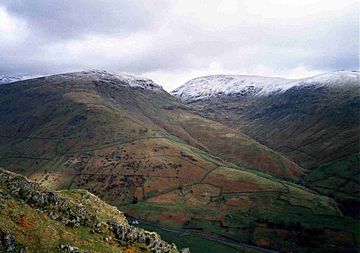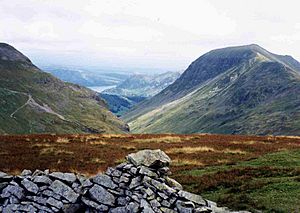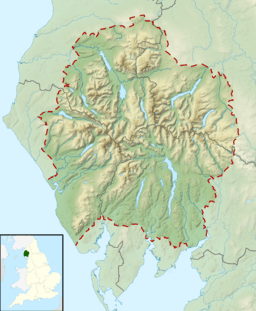Seat Sandal facts for kids
Quick facts for kids Seat Sandal |
|
|---|---|

Seat Sandal (left) and Fairfield (right)
seen from Helm Crag 2 km to the SW. |
|
| Highest point | |
| Elevation | 736 m (2,415 ft) |
| Prominence | c. 150 m |
| Parent peak | Fairfield |
| Listing | Hewitt, Marilyn, Nuttall, Wainwright |
| Geography | |
| Location | Cumbria, England |
| Parent range | Lake District, Eastern Fells |
| OS grid | NY343115 |
| Topo map | OS Landranger 90 OS Explorer 5 |

Seat Sandal is a mountain, or "fell," in the English Lake District. It is about 4 kilometers (2.5 miles) north of the village of Grasmere. You can see it very well from there. Even so, it is often less famous than its bigger neighbors in the Eastern Fells, like Helvellyn and Fairfield.
Contents
What Seat Sandal Looks Like
The western side of Seat Sandal, above Dunmail Raise, is smooth and covered in grass. But its eastern slopes are steep and rocky. They drop down towards a mountain pass called Grisedale Hause. This pass is 537 meters (1,762 feet) high. It holds Lakeland's highest large mountain lake, called Grisedale Tarn.
Seat Sandal reaches a height of 736 meters (2,415 feet). It just barely makes it onto the list of Marilyns. A Marilyn is a hill with a "prominence" of at least 150 meters. Prominence means how much a mountain rises above the lowest point connecting it to a higher peak. The name "Seat Sandal" comes from an old language called Norse. It means "Sandulfr's Hill Pasture," named after a person called Sandulfr.
Water Flow from the Mountain
Seat Sandal is special because its water flows to the sea in more different places than any other mountain in the Lake District.
- Raise Beck flows through Thirlmere and Derwent Water. It reaches the Irish Sea at Workington.
- Tongue Beck flows through Grasmere and Windermere. It reaches Morecambe Bay.
- Grisedale Beck flows into Ullswater. It then goes to the sea at the Solway Firth.
This unique water flow is partly because Raise Beck was changed to feed the Thirlmere Reservoir. Before this, another mountain called Dollywaggon Pike also shared this special feature.
On the eastern side of the mountain, there is a cool rocky feature called Gavel Crag. It connects to the main part of the mountain by a narrow rock ridge, called an arête.
Dunmail Raise is a pass that connects the Eastern Fells with the Central Fells. The mountain Steel Fell rises on the other side of this pass.
Rocks and Geology
The very top of Seat Sandal is made of a type of rock called andesite lava. The rocks below it are made of dacitic lapilli-tuffs. These are rocks formed from volcanic ash and fragments.
How to Climb Seat Sandal
You can climb Seat Sandal from Grasmere or from Dunmail Raise. Starting from Patterdale is also possible.
If you start from Grasmere or Patterdale, you will follow an old packhorse route. This path used to be used by horses carrying goods. Today, it is part of Wainwright's famous Coast to Coast Walk. When you reach Grisedale Hause, it is a steep climb to the top, following a broken wall.
If you start from Dunmail Raise, you follow the path of Raise Beck. This path goes up to about 580 meters (1,900 feet). From there, it is an easier walk south up gentle slopes to reach the summit. You can also climb directly up the western slopes, starting at Mill Bridge.
Views from the Top
The views from the summit of Seat Sandal are partly blocked by the taller Helvellyn and Fairfield mountains nearby. However, you still get a great view of the western Lake District. On a clear day, you might even see the Solway Firth and a mountain called Criffel. You can also see Morecambe Bay to the south.


